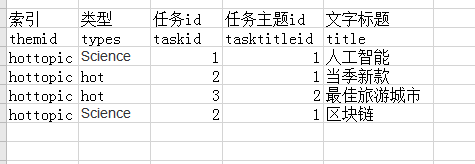溫馨提示×
您好,登錄后才能下訂單哦!
點擊 登錄注冊 即表示同意《億速云用戶服務條款》
您好,登錄后才能下訂單哦!
本篇文章給大家分享的是有關如何在java中使用elasticsearch進行分組,小編覺得挺實用的,因此分享給大家學習,希望大家閱讀完這篇文章后可以有所收獲,話不多說,跟著小編一起來看看吧。
java連接elasticsearch 進行聚合查詢進行相應操作
一:對單個字段進行分組求和
1、表結構圖片:

根據任務id分組,分別統計出每個任務id下有多少個文字標題
1.SQL:select id, count(*) as sum from task group by taskid;
java ES連接工具類
public class ESClientConnectionUtil {
public static TransportClient client=null;
public final static String HOST = "192.168.200.211"; //服務器部署
public final static Integer PORT = 9301; //端口
public static TransportClient getESClient(){
System.setProperty("es.set.netty.runtime.available.processors", "false");
if (client == null) {
synchronized (ESClientConnectionUtil.class) {
try {
//設置集群名稱
Settings settings = Settings.builder().put("cluster.name", "es5").put("client.transport.sniff", true).build();
//創建client
client = new PreBuiltTransportClient(settings).addTransportAddress(new InetSocketTransportAddress(InetAddress.getByName(HOST), PORT));
} catch (Exception ex) {
ex.printStackTrace();
System.out.println(ex.getMessage());
}
}
}
return client;
}
public static TransportClient getESClientConnection(){
if (client == null) {
System.setProperty("es.set.netty.runtime.available.processors", "false");
try {
//設置集群名稱
Settings settings = Settings.builder().put("cluster.name", "es5").put("client.transport.sniff", true).build();
//創建client
client = new PreBuiltTransportClient(settings).addTransportAddress(new InetSocketTransportAddress(InetAddress.getByName(HOST), PORT));
} catch (Exception ex) {
ex.printStackTrace();
System.out.println(ex.getMessage());
}
}
return client;
}
//判斷索引是否存在
public static boolean judgeIndex(String index){
client= getESClientConnection();
IndicesAdminClient adminClient;
//查詢索引是否存在
adminClient= client.admin().indices();
IndicesExistsRequest request = new IndicesExistsRequest(index);
IndicesExistsResponse responses = adminClient.exists(request).actionGet();
if (responses.isExists()) {
return true;
}
return false;
}
}java ES語句(根據單列進行分組求和)
//根據 任務id分組進行求和
SearchRequestBuilder sbuilder = client.prepareSearch("hottopic").setTypes("hot");
//根據taskid進行分組統計,統計出的列別名叫sum
TermsAggregationBuilder termsBuilder = AggregationBuilders.terms("sum").field("taskid");
sbuilder.addAggregation(termsBuilder);
SearchResponse responses= sbuilder.execute().actionGet();
//得到這個分組的數據集合
Terms terms = responses.getAggregations().get("sum");
List<BsKnowledgeInfoDTO> lists = new ArrayList<>();
for(int i=0;i<terms.getBuckets().size();i++){
//statistics
String id =terms.getBuckets().get(i).getKey().toString();//id
Long sum =terms.getBuckets().get(i).getDocCount();//數量
System.out.println("=="+terms.getBuckets().get(i).getDocCount()+"------"+terms.getBuckets().get(i).getKey());
}
//分別打印出統計的數量和id值根據多列進行分組求和
//根據 任務id分組進行求和
SearchRequestBuilder sbuilder = client.prepareSearch("hottopic").setTypes("hot");
//根據taskid進行分組統計,統計出的列別名叫sum
TermsAggregationBuilder termsBuilder = AggregationBuilders.terms("sum").field("taskid");
//根據第二個字段進行分組
TermsAggregationBuilder aAggregationBuilder2 = AggregationBuilders.terms("region_count").field("birthplace");
//如果存在第三個,以此類推;
sbuilder.addAggregation(termsBuilder.subAggregation(aAggregationBuilder2));
SearchResponse responses= sbuilder.execute().actionGet();
//得到這個分組的數據集合
Terms terms = responses.getAggregations().get("sum");
List<BsKnowledgeInfoDTO> lists = new ArrayList<>();
for(int i=0;i<terms.getBuckets().size();i++){
//statistics
String id =terms.getBuckets().get(i).getKey().toString();//id
Long sum =terms.getBuckets().get(i).getDocCount();//數量
System.out.println("=="+terms.getBuckets().get(i).getDocCount()+"------"+terms.getBuckets().get(i).getKey());
}
//分別打印出統計的數量和id值對多個field求max/min/sum/avg
SearchRequestBuilder requestBuilder = client.prepareSearch("hottopic").setTypes("hot");
//根據taskid進行分組統計,統計別名為sum
TermsAggregationBuilder aggregationBuilder1 = AggregationBuilders.terms("sum").field("taskid")
//根據tasktatileid進行升序排列
.order(Order.aggregation("tasktatileid", true));
// 求tasktitleid 進行求平均數 別名為avg_title
AggregationBuilder aggregationBuilder2 = AggregationBuilders.avg("avg_title").field("tasktitleid");
//
AggregationBuilder aggregationBuilder3 = AggregationBuilders.sum("sum_taskid").field("taskid");
requestBuilder.addAggregation(aggregationBuilder1.subAggregation(aggregationBuilder2).subAggregation(aggregationBuilder3));
SearchResponse response = requestBuilder.execute().actionGet();
Terms aggregation = response.getAggregations().get("sum");
Avg terms2 = null;
Sum term3 = null;
for (Terms.Bucket bucket : aggregation.getBuckets()) {
terms2 = bucket.getAggregations().get("avg_title"); // org.elasticsearch.search.aggregations.metrics.avg.InternalAvg
term3 = bucket.getAggregations().get("sum_taskid"); // org.elasticsearch.search.aggregations.metrics.sum.InternalSum
System.out.println("編號=" + bucket.getKey() + ";平均=" + terms2.getValue() + ";總=" + term3.getValue());
}以上就是如何在java中使用elasticsearch進行分組,小編相信有部分知識點可能是我們日常工作會見到或用到的。希望你能通過這篇文章學到更多知識。更多詳情敬請關注億速云行業資訊頻道。
免責聲明:本站發布的內容(圖片、視頻和文字)以原創、轉載和分享為主,文章觀點不代表本網站立場,如果涉及侵權請聯系站長郵箱:is@yisu.com進行舉報,并提供相關證據,一經查實,將立刻刪除涉嫌侵權內容。